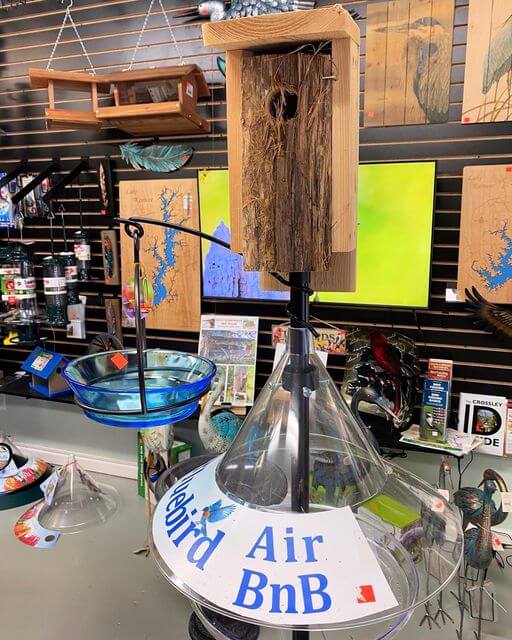Table of Contents
As the cooler days of fall settle in, you might be thinking about storing away your feeders. But hold on! Did you know that your hummingbirds are about to embark on an incredible journey? Many of our local hummers will soon be heading all the way to Mexico, and some northern travelers are passing through as well!
These tiny travelers have to double their weight—from the size of a dime to the size of a nickel—in order to survive their long migration. That means they need all the extra energy they can get, and your feeder can make a big difference.
Keep your feeders up through the end of October to help your birds refuel. This is one small way we can make a big impact on their long journey!
Need fresh nectar or a new feeder? We’ve got you covered. Stop by For The Birds, and we'll make sure your feeders are ready to go for our little flying friends.
Nourishment is crucial as these tiny birds expend immense energy traveling long distances. During this period, they rely heavily on reliable food sources to fuel their journeys. The primary diet of hummingbirds consists of nectar from flowers, which provides the essential sugars they need for energy. Additionally, they require protein from insects and spiders to support muscle development and overall health.
Setting up feeders filled with a sugar-water solution (one part sugar to four parts water) can significantly aid in their survival during migration. Planting native flowering plants can also attract these birds, providing them with natural food sources. It's vital to keep feeders clean and refill them regularly to ensure a continuous supply of nourishment. By providing accessible food, we can help them thrive and complete their arduous migrations, contributing to the health of these remarkable creatures and the ecosystems they inhabit.
When selecting bird feeders for hummingbirds during migration, consider these key features to attract and support these delicate travelers:
Nectar Feeders: Opt for feeders specifically designed for hummingbirds, featuring small feeding ports that prevent larger birds from accessing the nectar. Look for models with built-in ant moats to keep pests away.
Red Accents: These birds are drawn to bright colors, especially red. Choose feeders with red accents or add red ribbon or tape around them to attract these birds.
Easy to Clean: Select feeders that can be easily disassembled for thorough cleaning. Keeping feeders clean helps prevent mold and fermentation, which can harm hummingbirds.
Capacity: During migration, feeders with larger capacities can support more birds. Look for feeders that hold at least 12-16 ounces of nectar, allowing for fewer refills.
Multiple Ports: Feeders with several feeding ports allow multiple birds to feed simultaneously, reducing competition and stress during their stopovers.
By choosing the right feeders, you can create a welcoming environment for hummingbirds and help them stay nourished during their challenging migrations.
Hummingbird migration is a fascinating phenomenon that often surprises even the most avid bird watchers. These tiny birds embark on incredible journeys, demonstrating remarkable endurance and navigational skills. Here are some unique facts about hummingbird migration that many people might not know.
This species is known for their small size, but they undertake extraordinary migrations. For instance, the Ruby-throated Species migrates up to 3,000 miles from North America to Central America, often flying non-stop across the Gulf of Mexico. This journey can take up to 18 hours, during which they rely solely on their fat reserves for energy.
It is genius how these birds follow specific routes known as migratory corridors. These paths are not arbitrary; they often align with geographical features such as mountain ranges and coastlines, which provide guidance and stopover points. The use of landmarks helps them navigate effectively, even over vast distances.
The timing of migration is closely linked to seasonal changes and food availability. Most birds begin their southward migration in late summer or early fall, timed to coincide with the flowering of plants that provide nectar. Conversely, they return north in spring, as blooming plants become abundant.
Some species, like the Rufous, are known for their astonishing ability to fly non-stop for extended periods. During migration, they can cover distances of up to 500 miles in a single flight. To achieve this, they build up fat reserves, which can constitute nearly 40% of their body weight before setting off.
Interestingly, some exhibit social behaviors during migration. They often travel in groups, which can provide safety in numbers and increased foraging opportunities. Observing a flock of hummingbirds is a stunning sight, as they display intricate aerial maneuvers and vocalizations.
Climate change has a significant effect on migration patterns. As temperatures rise and blooming seasons shift, many are adjusting their migratory timings. Some species are arriving at their breeding grounds earlier in the spring, which can disrupt the balance of ecosystems and affect food availability.
Different species have evolved unique adaptations for migration. For example, the Anna's Hummingbird has been known to remain year-round in parts of the U.S., thanks to urban gardens providing ample nectar. Meanwhile, the Black-chinned Hummingbird has developed a more flexible migration schedule, adapting its journey based on environmental conditions.
Migration isn't just about the journey; it's also about the rest stops. Hummingbirds rely heavily on food sources along their migratory paths. Nectar-rich flowers and strategically placed feeders are crucial for their survival during these critical stops. Habitat loss threatens these essential feeding sites, making conservation efforts vital.
Migration is a testament to nature’s wonders, showcasing resilience, adaptability, and intricate behaviors. Understanding these unique aspects not only deepens our appreciation for these remarkable birds but also highlights the importance of protecting their habitats and migration routes for future generations. Whether observing their breathtaking flights or supporting their needs through gardens and feeders, we can play a role in their incredible journeys.
I want to extend my heartfelt thanks for taking the time to read my blog post on hummingbird migration. Your interest and engagement mean so much to me!
As we explored, these incredible little birds embark on extraordinary journeys that highlight their resilience and adaptability. I hope you found the insights inspiring and informative, and that they deepen your appreciation for these fascinating creatures.
Your support encourages me to continue sharing knowledge and fostering a community that cares for our feathered friends. If you have any thoughts or questions about the post, feel free to reach out—I’d love to hear from you!




